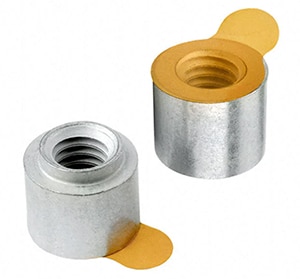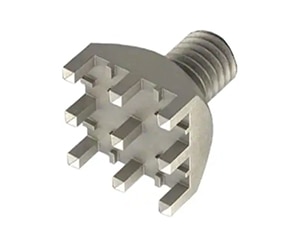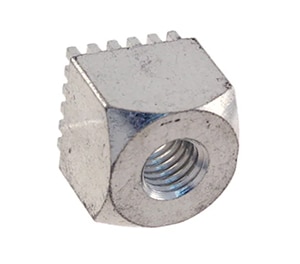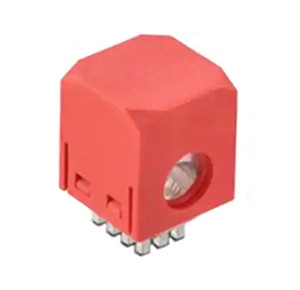How High-Current Terminals Can Safely Supply Power While Reducing Assembly Time and Power Loss
Contributed By DigiKey's North American Editors
2021-01-13
Designers of industrial systems are increasingly taking advantage of electronic control as they strive for efficiency. With electronic control comes the need for ever smaller form factors to save space and lower costs. However, as form factors shrink, designers face increasing challenges related to high-power connections. High-current pc board connectors and power lines require thick, heavy-duty connections and so cannot shrink at the same rate as digital electronics. In addition, these high-current connection points must be friendly to the pc board manufacturing process, whether it is surface mount or through-hole. These issues must be dealt with, while still managing tightening budgets and shorter time to market.
To meet these requirements, developers of high-power electronics must pay close attention to the design and selection of pc board high-power terminals and their assembly. High-current terminals can also require additional assembly time in order to guarantee a solid solder connection.
This article will briefly discuss the problems associated with high-power terminals. It will show how designers of high-power pc boards can benefit from specialized high-current pc board terminals. Using solutions from Würth Elektronik as examples, it will show how appropriate terminals can reliably deliver high current between systems and how they can accelerate automated assembly while providing high mechanical stability and very low connection resistance.
How terminals introduce power losses
Designers of industrial systems frequently need to supply and control high currents in the range of hundreds of amps. Often the high-current terminals supplying the power to the system are on the same pc board as the digital control electronics. As the control semiconductors become more highly integrated, the pc board decreases in area. This shrinking form factor presents three problems for designers of high-power electronics.
The first problem is accounting for the environmental extremes in terms of temperature, humidity, and gases on the pc board electronics. If connections are not air-tight, gases as a result of industrial processes can oxidize or corrode high-current connections, resulting in inefficient connections which can lead to power losses or equipment malfunctions. These problems can be difficult to diagnose and sometimes cannot be detected by even the most careful visual inspection.
The second problem is dealing with the efficiency of the high-power connections. As power levels rise, even the smallest increase in connection resistance can result in a power loss with a noticeable increase in heat. Per Ohms Law, a 25.0 ampere (A) terminal with a bad solder joint that results in a resistance of just 0.050 ohms (Ω) can generate a loss of (25.0² x 0.050) = 31.25 watts at the joint. Besides the losses, the heat generated can reduce the lifespan of nearby electronics. At worst, the heat could cause burns or a fire.
The third problem is ensuring that the high-current terminals are compatible with the manufacturing method used to assemble the pc board. For high-volume pc board manufacturing, surface mount is preferred for all components. Compared to through-hole, surface mount assembly combines reduced assembly times with lower labor costs while maintaining quality. However, surface mount pc board terminals are limited as to the current carrying capability for an individual terminal. Through-hole reflow pc board terminals can easily carry more current than surface mount, while providing very high mechanical stability. However, a through-hole or mixed pc board assembly line can require twice the floor space, as well as additional labor and assembly times compared to surface mount, making this a more expensive assembly method.
Regardless of the assembly process, quality must be maintained, and for an assembly line that means a focus on reducing errors. In this regard, through-hole may be more reliable for high-current terminals as the nature of the terminal makes it less likely it will pop out during the reflow soldering process. Because surface mount high-current terminals require larger footprints, it is critical that solder paste be applied evenly over the entire solder pad. If it is uneven, the pad will heat unevenly during solder reflow, causing one end of the terminal to rise, resulting in tombstoning of the surface mount component.
Power efficient high-current terminals
To address the potential problems with high-current terminals, Würth Elektronik has developed the REDCUBE terminals product line that support high currents with flexible manufacturing options. The terminals are low profile which allows for faster heat dissipation to ambient while allowing for more airflow to the immediate area, enhancing cooling to the surrounding electronics. REDCUBE terminals are designed for extremely low solder junction resistance and so can supply up to 500 A with very little power loss or heat generation.
The line supports surface mount, through-hole reflow, and press-fit pc board manufacturing processes. This allows an industrial systems pc board designer to standardize on terminals from a single supplier, makes them easy to visually identify during different manufacturing processes, and simplify purchasing.
Surface mount high-current terminals
For compatibility with surface mount device (SMD) pc board manufacturing, designers can use Würth’s REDCUBE SMD industrial terminal family. These terminals support fully automated surface mount assembly while emphasizing minimal heat generation. The terminals support up to 85 A for electrical board-to-board connections.
An example device, the 7466003R, has an M3 thread and is rated at 50 A at 20°C (Figure 1). The terminal has a small 8.3 millimeter (mm) diameter footprint. The circular footprint improves manufacturing yields by reducing tombstoning through even weight distribution of the terminal, and eliminating sharp corners that might not receive solder paste. The body of the REDCUBE SMD 7466003R is made of heavy-duty brass with a tin plating and is rated for temperatures of -55°C to +150°C.
 Figure 1: The REDCUBE SMD 7466003R industrial terminal has a small 8.3 mm footprint and is rated to safely carry up to 50 A. It is supplied with an attached orange mylar tab which is removed by automated pick and place equipment prior to surface mount pc board placement. (Image source: Würth Elektronik)
Figure 1: The REDCUBE SMD 7466003R industrial terminal has a small 8.3 mm footprint and is rated to safely carry up to 50 A. It is supplied with an attached orange mylar tab which is removed by automated pick and place equipment prior to surface mount pc board placement. (Image source: Würth Elektronik)
To provide the best connection while reducing heat, it is recommended that the M3 thread be mated to a screw and terminal that are also tin plated. This makes the 7466003R compatible with most power terminals and screws. An orange mylar tab protects the side to be soldered from contaminants and fingerprints before assembly. This helps ensure a good surface mount solder connection with minimal connection resistance. It is also recommended that before the terminal is mated to a tin-plated screw, the M3 thread and terminal top be protected from any contaminants that could affect the mating resistance of an inserted screw and tab. This includes keeping fingers off the top of the thread.
Through-hole pc board terminals
For industrial applications that require through-hole components, Würth provides the REDCUBE THR family. These support automated through-hole reflow pc board assembly. For example, the 74651195R is a nine-pin through-hole straight screw terminal with a tin-plated M5 thread designed to take a cable tab secured by a nut (Figure 2). It has an operating temperature range of -55°C to +150°C and is rated at 85 A at 20°C.
 Figure 2: The REDCUBE THR 74651195R is rated at 85 A at 20°C and has an M5 straight screw terminal. The nine pc board pins provide mechanical stability against shear and tearing forces. (Image source: Würth Elektronik)
Figure 2: The REDCUBE THR 74651195R is rated at 85 A at 20°C and has an M5 straight screw terminal. The nine pc board pins provide mechanical stability against shear and tearing forces. (Image source: Würth Elektronik)
The nine pins on the 74651195R are arranged in a 3 x 3 grid that is designed for optimal solderability as well as mechanical stability against tearing and shearing forces. The 74651195R is tin-plated over a solid piece of brass, giving it a higher current carrying capacity and better torque tolerance compared to stamped terminals. This design makes the 74651195R a good choice for high-power industrial applications where the attached cable may be pulled from any angle.
The 74651195R is low profile and has a total height above the pc board of 10 mm with a screw measuring 7 mm in length. This supports standard M5 cable tabs and lock nuts with little thread, easily allowing airflow around the terminal to enhance cooling.
Press-fit terminals for very high currents
For power supply and industrial systems applications requiring very high currents, Würth developed the REDCUBE PRESS-FIT product line that is rated up to 500 A. These terminals do not use reflow or wave soldering. Instead, the terminal is mechanically pressed into solder-plated pc board holes. The friction created by pressing the terminal into the pc board holes creates a cold weld connection that is gas-tight with a contact resistance as little as 200 micro ohms (µΩ).
A solution example is the 7461090 screw terminal with an M8 thread (Figure 3). It is rated at 350 A at 20°C and has an operating temperature of -55°C to +150°C. To handle this current, the 7461090 has 20 press-fit pins that do not require any heat soldering methods. The press-fit method uses the same pc board holes as through-hole components, eliminating any solderability issues such as cold solder joints. In addition, the 20 press-fit pins do not need to extend past the pc board like soldered through-holes and can even terminate inside the pc board without any solder tails. This helps prevent accidental shorts to the high-current terminal under the pc board, thereby improving system safety.
 Figure 3: The REDCUBE PRESS-FIT 7461090 industrial screw terminal is pressed into pc board holes without wave or reflow soldering methods. Its unique design provides very little contact resistance, allowing it to handle up to 350 A. (Image source: Würth Elektronik)
Figure 3: The REDCUBE PRESS-FIT 7461090 industrial screw terminal is pressed into pc board holes without wave or reflow soldering methods. Its unique design provides very little contact resistance, allowing it to handle up to 350 A. (Image source: Würth Elektronik)
The profile of the M8 tin-plated thread is 13.5 mm. For maximum current delivery with minimum contact resistance, a tin-plated screw should be chosen such that the assembled screw goes through the cable tab and travels the maximum length practical through the REDCUBE terminal without coming into contact with the pc board. This provides the maximum contact area for the entire screw terminal length.
Before assembly, it is important to prevent any contaminants or fingers from coming into contact with the thread or the top of the terminal, as even the smallest resistance from contaminants can generate a dangerous amount of excess heat at 350 A.
Plug terminals for easy connect and disconnect
Sometimes a high-power industrial system needs to be easily reconfigured and reconnected between different sources. For these applications, Würth provides the REDCUBE PLUG press-fit industrial terminal receptacle family. This is a press-fit terminal that offers the convenience of a screwless terminal connection that can support up to 120 A.
For example, the REDCUBE PLUG 7464000 can handle up to 120 A at 20°C with an operating temperature range of -45°C to +125°C (Figure 4). This REDCUBE PLUG consists of a tin-plated copper alloy receptacle encased in a red glass fiber-reinforced plastic housing. To insert a compatible plug into the 6.2 mm diameter receptacle, the top of the housing must be manually depressed towards the pc board. This fully exposes the receptacle for easy insertion of a tin-plated plug. Releasing the top of the housing locks the plug in place.
 Figure 4: The REDCUBE PLUG 7464000 plug receptacle is a press-fit terminal rated at 120 A at 20°C. It provides for easy connect and disconnect of high-current plugs, making it appropriate for reconfigurable power solutions. (Image source: Würth Elektronik)
Figure 4: The REDCUBE PLUG 7464000 plug receptacle is a press-fit terminal rated at 120 A at 20°C. It provides for easy connect and disconnect of high-current plugs, making it appropriate for reconfigurable power solutions. (Image source: Würth Elektronik)
The REDCUBE PLUG 7464000 plug receptacle is also a good solution for areas with low overhead space that would make it difficult to attach a screw or nut. The bright red color makes the plug easily identifiable on a crowded pc board. It has 12 tightly spaced press-fit pins arranged in a 3 x 4 grid. The 7464000 provides a maximum contact resistance of 1 mΩ, making it appropriate for very high-current applications.
Conclusion
As designs get more integrated, designers of high-power systems must balance efficient, low-loss power delivery with ease of assembly. This makes the selection of the appropriate high-current pc board industrial terminals particularly crucial. Designers must have an understanding of the board assembly process, the amount of current that a terminal can safely handle, and the method of pc board attachment.
As shown, industrial grade terminals with flexible assembly options allow a designer to standardize on one product line, simplifying purchasing and interoperability. This allows industrial systems to safely deliver power while increasing manufacturing yields by minimizing assembly errors, resulting in faster assembly times and lower costs.

Disclaimer: The opinions, beliefs, and viewpoints expressed by the various authors and/or forum participants on this website do not necessarily reflect the opinions, beliefs, and viewpoints of DigiKey or official policies of DigiKey.









